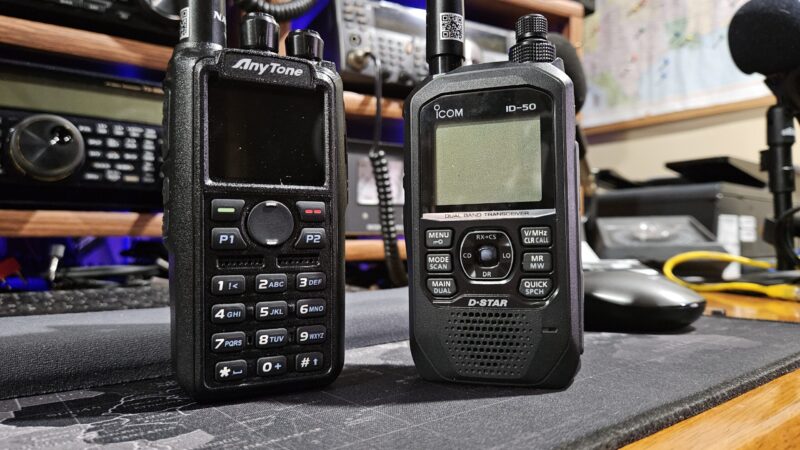
Anytone 878 vs Icom ID‑50A. The AnyTone AT‑D878UVII Plus (commonly called the “878”) and the Icom ID‑50A—puts into sharp relief the trade‑offs between price, performance, and ergonomics. Below is a deep‑dive blog comparing these models across price, receive quality, build quality, battery life, and user satisfaction, and contrasting their underlying receiver architectures.
Price Comparison
- AnyTone AT‑D878UVII Plus
Street price: $329–$335. BridgeCom lists it at $329.99 with free USB‑C battery and training letsgetreadyinc.comBridgeCom Systems. Ham Radio Outlet offers it at $334.99 Ham Radio Outlet. - Icom ID‑50A
Street price: $399.95 (after promotions) according to Ham Radio Outlet Ham Radio OutletR&L Electronics. GigaParts and R&L Electronics also show $399.95 as MSRP GigaPartsR&L Electronics.
Bottom line: the 878 runs about $65–$75 cheaper, freeing up funds for accessories (extra battery, programming cable, protective case).
Receive Quality
AnyTone 878 (Direct‑Conversion Receiver)
- Employs a direct‑conversion (zero‑IF) architecture: RF is mixed directly to baseband, then digitized by DSP.
- Pros: Fewer analog IF filters, hot sensitivity—users note “very hot receiver” on par with commercial radios RadioReference.com Forums.
- Cons: Susceptible to strong‑signal overload and spurious responses if connected to high‑gain antennas without additional front‑end filtering RadioReference.com Forums.
Icom ID‑50A (Superheterodyne Receiver)
Cons: Slightly narrower instantaneous bandwidth; less “hot” than the 878 in pure sensitivity tests, but far more robust in congested RF environments.
Uses a double‑conversion superheterodyne design with multiple IF stages and high‑quality roofing filters—typical of Icom’s transceiver lineup Associated Radio.
Pros: Excellent selectivity, strong‑signal handling, and spurious‑rejection (55 dB FM selectivity, >60 dB spurious rejection) Icom America..
Build Quality
| Feature | AnyTone 878 | Icom ID‑50A |
|---|---|---|
| Ingress Protection | IP‑54 (dust & splash resistant) | IPX7 (1 m water submersion, 30 min) Icom America. |
| Materials | ABS plastic housing; metal belt clip | Polycarbonate/ABS blend; pro‑grade chassis Icom America. |
| Weight | 282 g (with 3100 mAh battery & antenna) anytone.org | 300 g (with BP‑272 pack & antenna) Icom America. |
| Ergonomics | Chunky keypad, programmable “orange” side buttons | Slimmer profile, large tactile knobs and buttons Icom America. |
- AnyTone: Feels solid for a sub‑$350 radio and can withstand drops, but splash protection only.
- Icom: More refined feel, better seals against rain, and IPX7 rating for serious outdoor use.
Battery Life
- AnyTone 878
- 3100 mAh Li‑ion USB‑C battery.
- Up to 35 hours in power‑save receive mode anytone.orgeHam.net.
- Full charge in ~2–5 hours via desktop charger or USB‑C.
- Icom ID‑50A
- BP‑272 (supplied) 7.4 V Li‑ion pack: ~8 hours (Tx : Rx : standby = 1 : 1 : 8) Icom America..
- BP‑307 (option) pack: extends to ~12.5 hours Icom America..
Verdict: The AnyTone’s large 3100 mAh cell easily outlasts Icom’s stock pack and rivals even Icom’s BP‑307 option—ideal for long nets or field operations without recharging.
User Satisfaction
AnyTone 878
- eHam.net reviewers praise the loud speaker, solid feel, and customizable display eHam.net.
- Reddit feedback highlights “battery life is amazing—literally lasts days” and “Bluetooth for headsets works great” Reddit.
- BridgeCom Systems customers rave about “5‑star US‑based support” and “guided training” that flatten the learning curve BridgeCom Systems.
Icom ID‑50A
- Reddit consensus: audio quality on transmit/receive is “crystal clear and punchy”—“I’ll never buy another Yaesu after this” Reddit.
- Common praises: intuitive D‑STAR setup, band‑scope waterfall, and picture‑share function.
- Gripes: UI/menu complexity—manual translation issues; some users find key feedback “clicky” and curve steep at first Reddit.
Receiver Architectures: Pros & Cons
| Aspect | Direct Conversion (AnyTone) | Superheterodyne (Icom) |
|---|---|---|
| Complexity | Simpler IF chain; largely DSP‑based | Multiple analog IF stages + DSP |
| Cost | Lower component cost → lower retail price | Higher cost for roofing filters, mixers, oscillators |
| Sensitivity | Very high; minimal analog filtering losses | Very good; slightly lower noise floor |
| Selectivity | Relies on DSP filters; can have leakage | Excellent; fixed crystal filters + DSP |
| Robustness | Prone to DC‑offset issues, LO drift | Handles strong signals and spurs gracefully |
- Direct Conversion Pros: Hot sensitivity, wide DSP‑based filtering, compact design.
- Direct Conversion Cons: Overload easily by strong local transmitters, DC offsets require careful calibration.
- Superhet Pros: Rock‑solid front‑end, great off‑axis rejection, proven performance in crowded bands.
- Superhet Cons: Slightly larger RF footprint, marginally higher power draw, and higher BOM cost.
Which to Choose?
- Budget‑minded operator who wants long battery life, hot receive on both analog and DMR, and can accept splash protection: AnyTone 878.
- Performance‑driven operator who values top‑notch selectivity, rugged waterproofing, and an extensive D‑STAR feature set: Icom ID‑50A.
Anytone 878 vs Icom ID‑50A, so what’s the verdict? Both are excellent radios that reflect their architectures’ strengths. It may come down to DV mode preference? DMR vs D-star. Of course, it may depend on your local area. What repeaters will you have access to? Maybe a hotspot is the answer? I own both radios. Honestly, I like them both. I do find it’s fairly easy to cross-mode with my Openspot 4 Pro using the ID-50. I can link/unlink from DMR talk-groups directly from the radio which is nice. The AnyTone edges out on price and uptime, while the Icom shines in RF environments demanding tight filtering and in‑field usability under harsh conditions. Whichever you pick, you’ll be well armed for the on‑the‑go world of VHF/UHF ham operations. Have fun! 73
